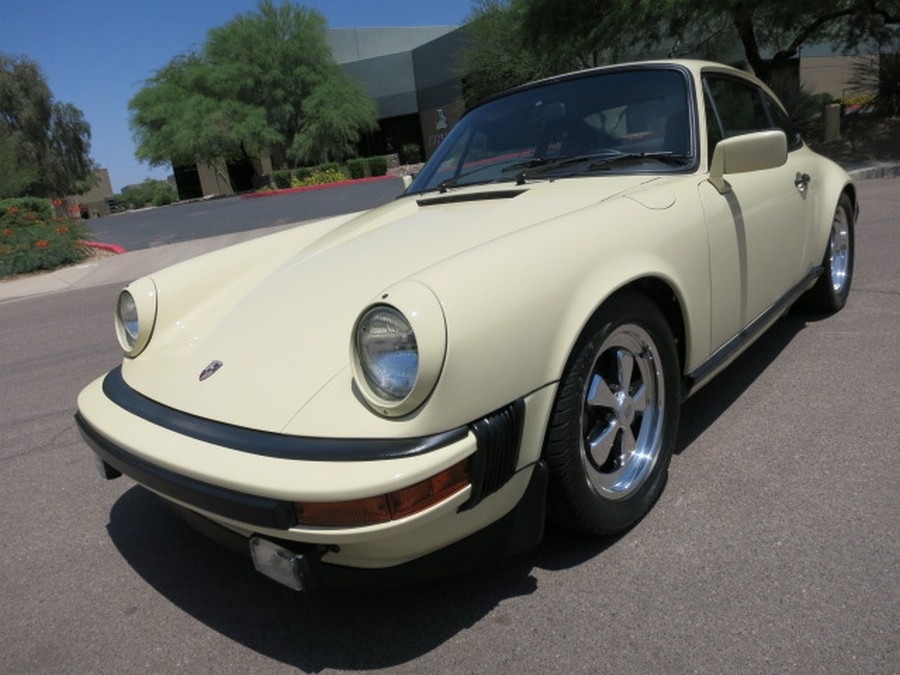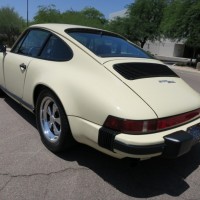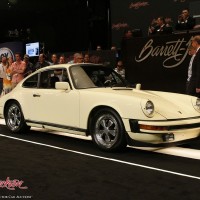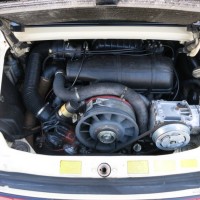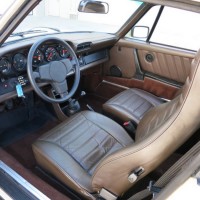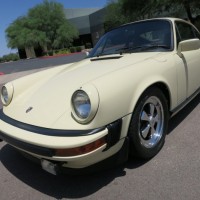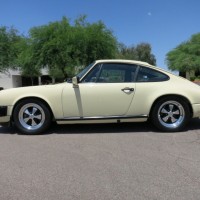SCM Analysis
Detailing
| Vehicle: | 1980 Porsche 911SC |
| Number Produced: | 9,874 in 1980; total SC production was 64,763 |
| Original List Price: | $27,700 |
| Tune Up Cost: | $1,200 to $1,500, including valve adjustment |
| Chassis Number Location: | Inner left front fender aluminum plate; stamping above fuel tank |
| Engine Number Location: | Under fan on right-side upright |
| Club Info: | Porsche Club of America |
| Website: | http://www.pca.org |
| Investment Grade: | C |
This car, Lot 92.1, sold for $35,750, including buyer’s premium, at Barrett-Jackson’s Las Vegas auction on September 26, 2013. People have asked how far out of bounds that price was for a car that commentators tag as their recommended “budget 911.” Although it certainly was high for this example, the price achieved here need not be out of bounds. Sunny days for SCs and their Carrera 3.2 successors are arriving.
Porsche fans reacted very favorably when the 911SC debuted in the fall of 1977. It was patterned directly after the European-only, limited-production Carrera 3.0 from 1976–77. The new car benefited from replacing the often — and justifiably — maligned 1974–77 model with its emissions-strangled 2.7-liter CIS engine. Porsche enthusiasts were ready for improvements.
The primary benefit was an improved 2,994-cc engine, still in the flat boxer 6-cylinder layout used since the 911’s birth — but now with 180 horsepower. That rating improved to 188 hp in 1978 and to 204 hp in 1981 — thanks to a bump in the compression ratio from 8.6:1 to 9.8:1. For strength, both the engine case and the gearbox housing were switched from magnesium to aluminum. In 1980, the Turbo radiator-style oil cooler was used on all 911s for the first time.
One body for 16 years
The G-Series body had been introduced in 1974 to accommodate federally mandated 5-mph impact bumpers. It became known as the “high-bumper” or “short-hood” 911. The G-Series body was carried forward to the SC — and then to the 3.2-liter Carrera of 1984–89. All told, it lasted for 16 model years. Along the way, the 911 began to look dated, and sales suffered. From an all-time high (to that point) of 15,438 units in 1973, sales declined to 8,189 in 1975, bounced back, then declined again to as low as 8,698 in the middle of the SC’s run.
Starting in 1976, Porsche hot-dipped their bodies in zinc chromate for rust protection, which was a meaningful — but not foolproof — step forward. Porsche introduced a six-year rust warranty for the pan and chassis, extended in 1981 to seven years and to all of the body. Ergonomics, comfort and convenience were also steadily improved. Automatic heating controls, standard electric power windows, improved center console and headlight cleaners were among the added features.
At introduction in 1978, Porsche widened the SC’s rear fenders to accommodate seven-inch-wide rear wheels, again taken from the limited-production Carrera 3.0. In 1980, the model added optional 16-inch road wheels. In 1982, the all-black, powder-coated wheel centers were introduced, along with optional Turbo front spoiler and rear wing.
The convertible returns
In 1983, enthusiasts cheered when Porsche reintroduced a convertible to the model lineup. Porsche hadn’t built a convertible since the 356 expired with the 1965 model year. The 356 cabriolet was belatedly replaced in 1967 with the Targa, first with a soft zip-out rear window, then in 1969 with the much more common glass rear window. Porsche prided itself on the safety and comfort provided by the Targa versus a traditional convertible. However, customer research continued to show strong buyer interest in a true convertible, and as Porsche stretched to build sales volume, the convertible returned.
When the Carrera 3.2-liter SC replaced the SC in 1984, Porsche persevered with steady small improvements. Still, the long life of the G-Series body made the 911 look bland. Then 1990 arrived, and the 911 body style began to change.
A dated, collector-proof car — until now
Starting with the 964 in 1990, 911s had modern-looking body-colored bumpers, then the tautly sculpted body of 1995’s 993, and lastly, the larger, muscular 997 in 2005. And yes, I purposely ignored the largely forgettable 996 design of 1990–94.
During this progression of mostly attractive and modernized styling, the 1974–89 body style looked dated. It also was devoid of the nostalgic appeal of the low-bumper body of the original 1963–73 911s. The SCs and Carrera 3.2s went unloved for a long time. Excepting some special models, such as the 1989 Speedsters, various Anniversary editions, and Turbo-Looks (see the August 2013 German Profile, p. 64), the high-bumper 911 went unloved and uncollected.
This situation began to change a few years ago, when the G-body-style cars became old enough to look nostalgic. After all, there were people who grew up in that era lusting after Porsches of the day.
Those teenagers are now 35 to 52 years old and, voila, they are collecting cars. Some of them want the 911 of their teenage dreams. We also know of big-time collectors who see a place in their collections for these 911s, especially the scarce special editions and Turbos.
A fair price indicative of a moving market
At Barrett-Jackson’s Las Vegas auction, our subject car sold for $35,750, despite this auction not being especially Porsche-friendly — only two Porsches in more than 800 lots.
Despite the car showing only 15,052 miles, SCM’s Dan Grunwald (January 2014, p. 78) reported that it was fully repainted, with obvious flaws in the paint and interior. This SC also carried a boring color — ivory. The car had updated (thus operational) air conditioning, fog lights, and tinted glass — presumably film — all around. The black rubber and plastic trim looked decent, not so the weatherstripping. The non-stock chrome finish on the Fuchs alloy wheels and an engine compartment that needed detailing were additional drawbacks. Hopefully, it already had the updated Carrera 3.2 cam-chain tensioners.
At almost $36,000, I think this SC was well sold. However, SCs and Carrera 3.2s will continue to appreciate, especially in prime condition and in interesting colors (not to include Guards Red). Why? Because the only older, more nostalgic alternatives, the low-bumper 1963–73 911s, are sprinting out of sight. ♦
(Introductory description courtesy of Barrett-Jackson.)
